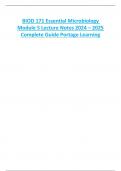Exam (elaborations)
BIOD 171 Essential Microbiology Module 5 Lecture Notes 2024 – 2025 Complete Guide Portage Learning
BIOD 171 Essential Microbiology
Module 5 Lecture Notes 2024 – 2025
Complete Guide Portage Learning
[Show more]
Preview 3 out of 17 pages
Uploaded on
August 23, 2024
Number of pages
17
Written in
2024/2025
Type
Exam (elaborations)
Contains
Unknown
Institution
BIOD 171
Course
BIOD 171
$15.49
Also available in package deal from $40.49
100% satisfaction guarantee
Immediately available after payment
Both online and in PDF
No strings attached
Also available in package deal (1)
1. Exam (elaborations) - Biod 171 essential microbiology module 5 lecture notes 2024 – 2025 complete guide...
2. Exam (elaborations) - Biod 171 essential microbiology module 1 notes 2024 – 2025 complete guide portage...
3. Exam (elaborations) - Biod 171 essential microbiology module 3 notes 2024 – 2025 complete guide portage...
4. Exam (elaborations) - Biod 171 essential microbiology module 6 notes 2024 – 2025 complete guide portage...
5. Exam (elaborations) - Biod 171 essential microbiology module 4 notes 2024 – 2025 complete guide portage...
Show more
BIOD 171 Essential Microbiology




